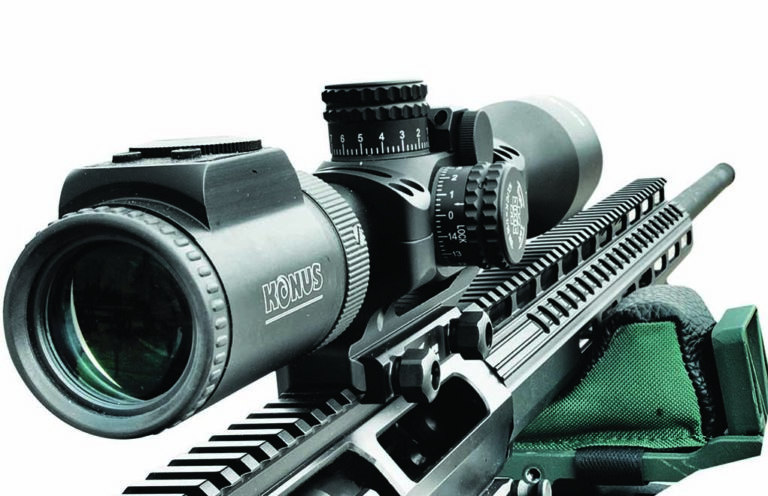
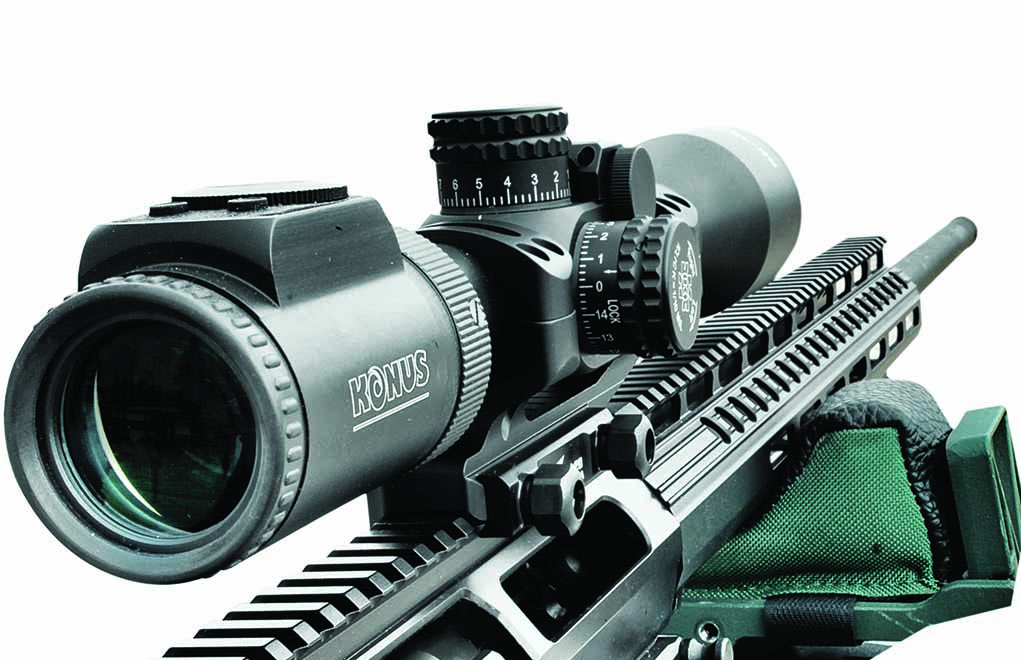
No matter your shooting situation (or range) the Konus EL-30 sets you up for success with a multitude of reticle options at the push of a button.
How the KonusPro EL-30 Is Ready For Any Shooting Task:
- The scope has 10 LCD reticles a shooter can cycle through to meet their needs.
- Five of the reticles are configured for long-range, three hunting and two close quarters.
- The scope still retains traditional windage, elevation and magnification adjustments.
When it comes to selecting an optic, we usually consider the overall quality, then the magnification range and lastly, features such as locking turrets, zero stop and any other bells and whistles.
However, an experienced shooter will take note of one critical, yet often overlooked, component: the reticle. In many ways, selecting the correct reticle will mean more than magnification range.
Let’s take a certain gun writer in his younger days, for example. Hell-bent on taking his .308 Winchester out past 600 yards, he purchased a mid- to high-end optic designed for benchrest shooting. While the optic gave him an 8-32x magnification, it left him just shy of adjustment by 3 mils for 1,000-yard shooting, even after shimming to the point of costing him a 100-yard zero.
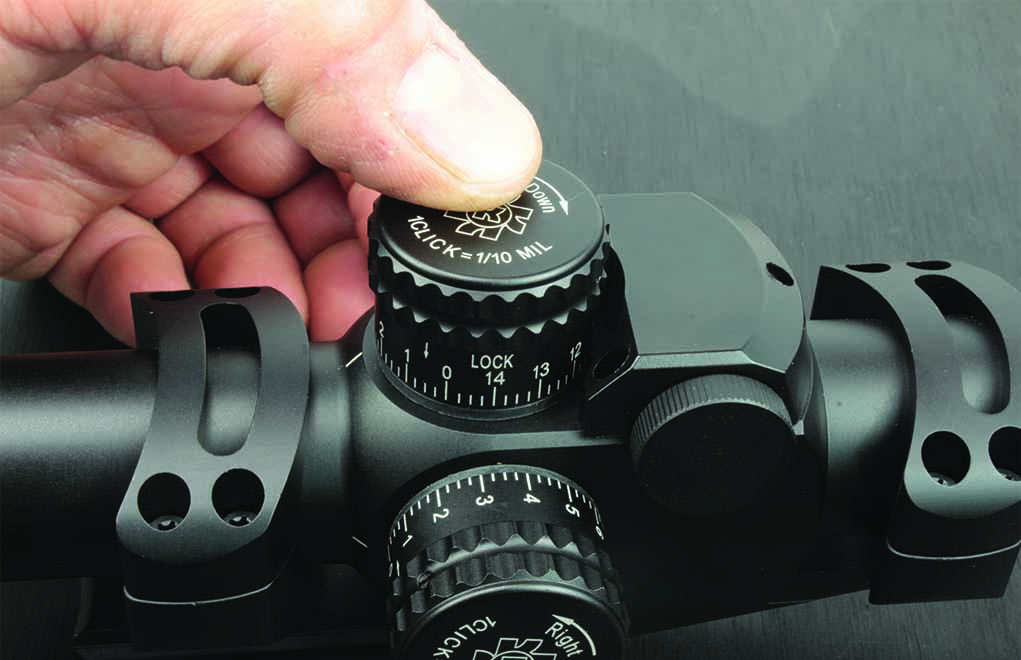
Naturally, most of us would just “make it up in the crosshairs” and use some of the mil dots to score a hit … except that’s where the problem sits—no mil-dots. Yes, this young enthusiast drank the “BDC Kool-Aid” of the early millennium, and in place of useful subtensions were arbitrarily spaced bubbles. While BDC can be a lifesaver for quick hunting shots inside 400 yards, they really become a hindrance at distances past that.
Eventually, that scope came off and another scope (of smaller magnification) that housed a standard mil-dot reticle was mounted in its place. Years later, this long-range rifle was retired to midrange hunting service, and—you guessed it … got the BDC glass back!
If you mount your own scope (and I highly recommend that you do), you understand the frustration of perfectly aligning your optic for eye relief and the diligent work associated with eliminating any cant. When it comes to precision, this process is arduous enough so that you don’t want to have to do it twice. Using a QD mount is a great solution; however, a perfect return to zero is seldom obtained.
Scope Out These Optics Articles:
- Which Focal Plane Is Right For You?
- Picking The Right Scope Power
- Secrets To Mounting A Scope On A Long-Range Rifle
- Why It’s Crucial To Test Your Riflescope's Tracking
- Buying the Perfect Precision Scope
Enter the KonusPro EL-30
This is where the Konus KonusPro EL-30 gathered its inspiration from. With an innovative LCD reticle, a shooter can change their crosshairs to suit their current needs on the fly with just the press of a button. Although technology got thrown in the mix, the optic still retains traditional windage and elevation adjustments, along with a typical rotating collar for magnification change.
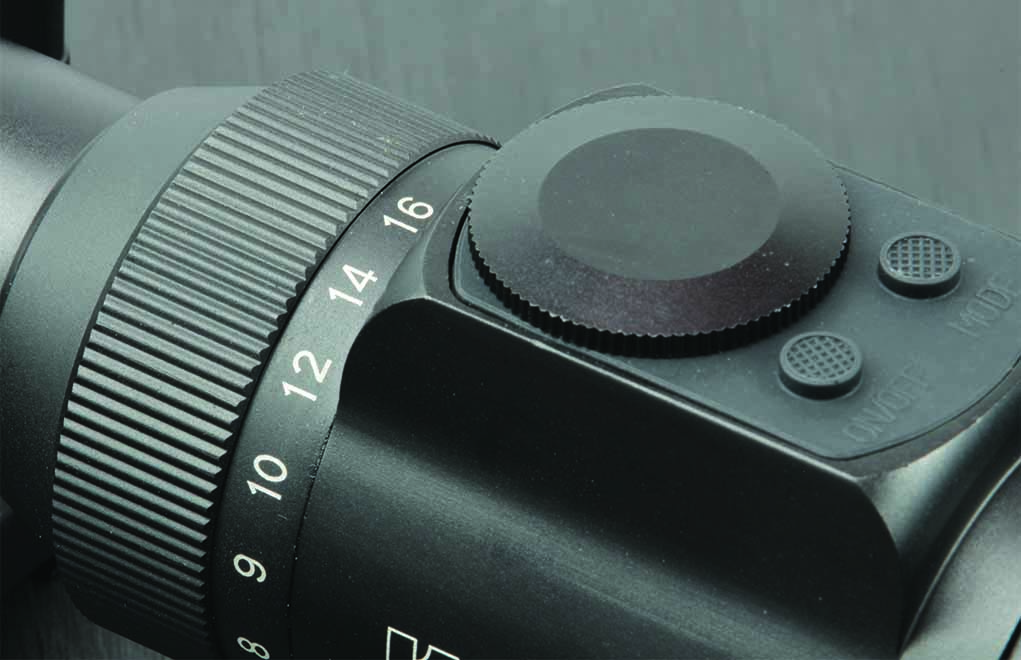
I liked this level of simplicity, because it makes for a very smooth learning curve. Overall, there are only two buttons, both of which are easily accessible in any shooting position. These two buttons are located on top of the ocular bell. The left one controls power (“on” or “off”), and the right one controls reticle choice. Pressing this button cycles the unit through its 10 selections, offering the perfect fit for hunting, as well as long- or close-range shooting. All reticles are positioned on the second focal plane and are true at 16x magnification. This allows the crosshairs to remain easily visible at the lower settings and lets you double or even quadruple the amount of adjustment you have in your reticle by cutting the power to 8x or 4x, respectively.
For the Hunter
For simplicity’s sake, let’s consider “hunting” to be big game at distances inside 300 yards. Reticles M1, M2 and M8 all accommodate your meat-harvesting needs. All three reticles are large enough to see in low light—which is when the majority of your shots will take place—and don’t have the clutter of windage subtensions. Shots inside traditional hunting distances don’t require any wind call, so it doesn’t make sense to add something that’s just going to obstruct your view of something important, such as how many points are on those antlers.
For Close Range
However, 4x zoom does still offer a bit of “run and gun” ability. It won’t have the larger, more natural, field of view of 1 or 1.5x, but it’ll still do the trick if this optic is mounted to a multipurpose rifle such as, say, an AR-15. Reticle M10 offers a dot with halo configuration that spans .4 mils at 4x and 1.6 mils at 16x. Reticle M9 offers the same configuration, except with a horizontal line cutting through it that can be used to judge lead or just confirm a level rifle in an awkward shooting position.
For Long Range
If you’ve opted to mount your KonusPro to your favorite long-distance carrier, 16x power will get you on a silhouette out to just about the distance a standard caliber is capable of. Reticles M3, M4, M5, M6 and M7 offer variations of mil lines and dots that span down the entire length of the crosshairs, allowing for elevation adjustment on the fly. Reticles M4 and M5 offer a “Christmas tree” dot system that spreads out farther as it gets closer to the bottom of your field of view.
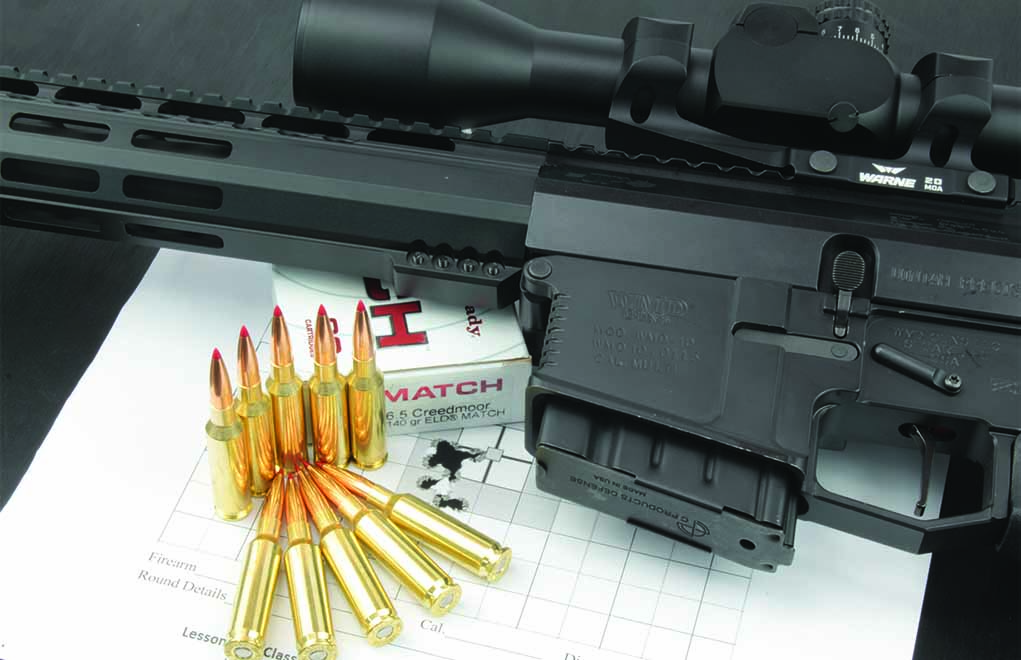
I’ve always considered this to be one of the most well-thought-out designs, because wind deflection gets greater with distance. This system not only considers that, it also reduces glass clutter by eliminating markings where they simply aren’t needed.
Setting it Up
Before range day, I built a rifle with the sole purpose of wringing out every possible last drop of accuracy. The idea is that when I want to test a scope, that’s all I want to be testing. Essentially, it’s the basic scientific method, and I’m trying to ensure that the only conceivable accuracy-robbing variable could be the optic.
To do so, I started with a WMD AR-10 lower receiver (WMDguns.com; $289) and completed it with an ultra-light Trigger Tech AR Diamond drop-in trigger (Triggertech.com; $299) and a LUTH-AR MBA-1 adjustable buttstock (Luth-AR.com; $139). Once completed, I snapped on a Uintah Precision bolt-action 6.5 Creedmoor upper receiver (UnintahPrecision.com; $1,295) and capped it off with a Kahntrol Solutions HexMod Brake (StopRecoil.com; $94.99).
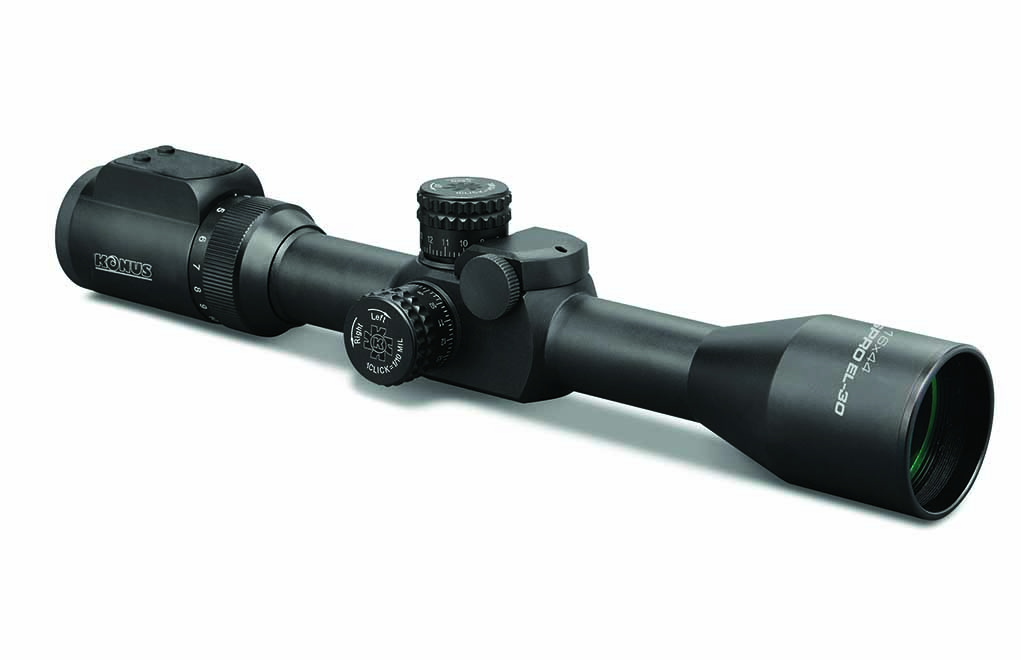
Turning my attention to the scope mount, I chose a Warne Xskell one-piece base/ring combo set (WarneScopeMounts.com; $139.49), quickly positioned the Konus optic for proper eye relief and torqued it down evenly to my rifle. After stocking up on 140-grain Hornady Match ammo, I hit the range to test its function and repeatability.
On The Range and … in the Kitchen?
I had some mild weather at the range for testing. The wind was all but absent, and temperatures were in the low 70s (not a bad day to be me!).
After 20 rounds to break in the rifle and help settle the stock and every screw involved, I zeroed the new optic in just a few shots. During this time, I took notice of the locking turrets, as well as how locking them down doesn’t affect zero. After I had a good sub-MOA zero, I set up a tall target test to confirm tracking.
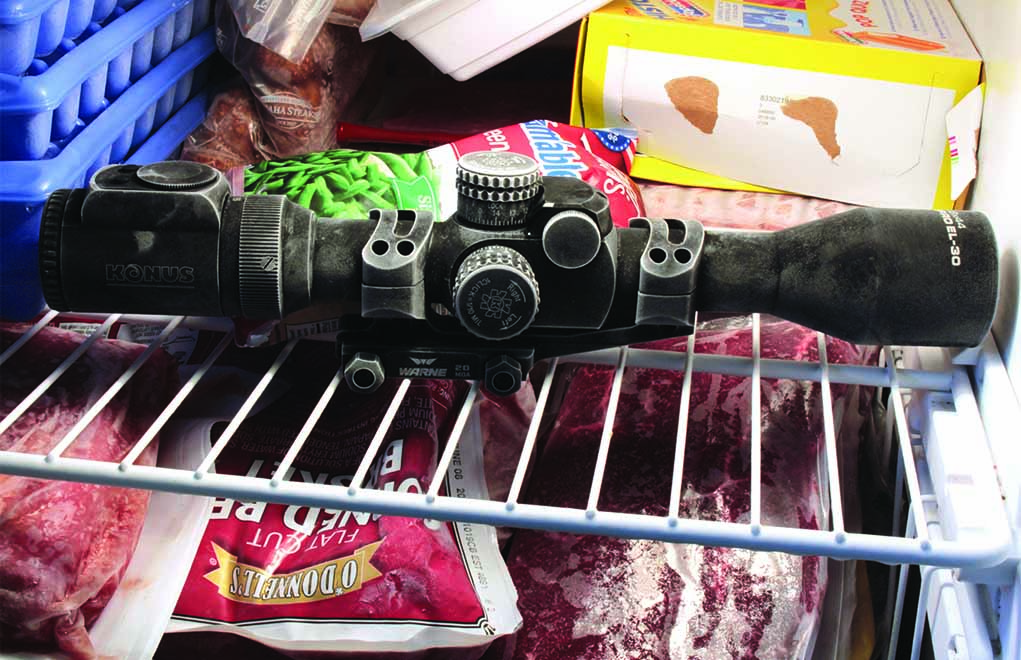
This tall target test involves a long sheet of paper (such as the back of a paper pistol silhouette) and a level. At an exact 100 meters (yards for MOA), you position the target, draw a level line from top to bottom, and give yourself a sub-MOA “bullseye” to aim at; it will be located at the very bottom of the line. Once your target is up, you fire a five-shot group to confirm you’re on the dot and right in line.
Next, adjust 2 mils up and fire a three-shot group. Repeat until you run off the paper. Then, you return to your zero setting and fire another group; it should be on top of your original group. The goal is to see if your impacts are moving the correct amount you dialed for and then return to where they belong.
Before that final group is fired, I also like to crank the windage turret throughout its entire range to confirm that it tracks properly as well. The optic passed that test, with all groups measuring under an 1 inch (impressive for a factory gun with factory ammo).
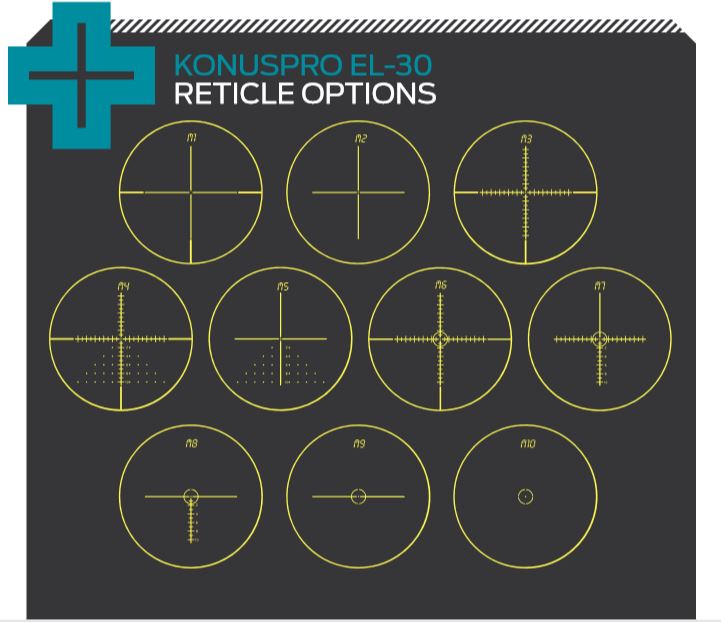
The last query I had was whether there was any zero loss when changing from reticle to reticle, so I set out another target and fired one shot with each reticle setting. The entire 10-shot group was still inside of an inch—simply amazing!
My last test for the Konus LCD reticle scope was of the reticle itself. The “L” in LCD stands for “liquid,” which means it can freeze. I hunt in the Northeast most of the time, and sub-freezing temperatures are the norm. Thinking back to the cheap LCD watch that lives in my hunting bag, that thing stops if it gets cold enough.
That being said, I unmounted the scope and stuck it in the freezer somewhere between the frozen peas and the ice cream that somebody keeps eating at 2:00 a.m. when they get up to go to the bathroom. I left the scope in the freezer until the next morning.

When I took it out, it was covered in ice crystals, the glass was fogged up … but the reticle still worked. It changed and powered off and on just the same as when it was in the sun on that 70-degree day. After an hour, I checked the glass again, and there was no sign of internal moisture—indicating a job well done with fog-proofing. Admittedly, I left the reticle on the night before and, to my surprise, it was still on in the morning.
When I reached out to Konus about battery life, all they had to say was, “We stopped testing after a week of straight runtime.” This prototype doesn’t have an automatic shutoff; however, the final production version that’s currently for sale does.
Casing Up
Konus has always been able to pull off some sort of Italian “voodoo” whereby it brings a remarkable product to the table—without a heavy price point. The KonusPro EL-30 can be purchased on OpticsPlanet.com for a measly $399.99. It’s some of the clearest glass I’ve ever looked through. When you factor in the utility of this optic, you could easily justify three times that amount, because it can replace three different optics.
KonusPro EL-30 Specs:
Color: Black
Magnification: 4-16x
Objective Lens Diameter: 44mm
Tube Diameter: 30mm
Reticle: 10, interchangeable
Eye Relief: 78-85mm, 3-3.3 inches
Exit Pupil: 2.7-11mm
Adjustment Click Value: 0.1 mil rad
Adjustment Range: 63.7 inches@100 yards
Field Of View (Linear): 9.5-22.6 feet@100 yards; 2.89-6.8 meters@100 meters
Optical Coating: Fully multi-coated
Water Resistance Level: Waterproof
Shockproof: Yes
Fog Proof: Yes
Length: 333mm; 13.1 inches
Weight: 23.39 ounces; 663 grams
Fabric/Material: Aluminum
Additional Features: Lock tactical turrets, LCD technology
The article originally appeared in the November 2019 issue of Gun Digest the Magazine.
For more information on the KonusPro EL-30, please visit konus.com.

![Best Concealed Carry Guns In 2025 [Field Tested] Wilson Combat EDC X9S 1](https://gundigest.com/wp-content/uploads/Wilson-Combat-EDC-X9S-1-324x160.jpg)


![Best 9mm Carbine: Affordable PCCs [Tested] Ruger Carbine Shooting](https://gundigest.com/wp-content/uploads/Ruger-Carbine-Shooting-100x70.jpg)
![Best AR-15: Top Options Available Today [Field Tested] Harrington and Richardson PSA XM177E2 feature](https://gundigest.com/wp-content/uploads/Harrington-and-Richardson-PSA-XM177E2-feature-100x70.jpg)

One problem with this scope, how do you zero the turrets?
Having an illuminated G3 small “Xmas tree” reticle in my Bushnell ELOTE LRTS 4.5 – 18 x 44 scope I’d take the KONUS M4 reticle. I like having a reticle that is easy to use for wind holds. Plus I cut my teeth on a “big Xmas tree” H59 reticle on my competition rifle so I know how to use them in many conditions.
If you think a reticle like theM4 or my G3 is “too busy” then I suggest you shoot with it for a day on the range. You soon begin to like having those horizontal holds at various wind conditions and magnifications (with FFP reticles, of course).